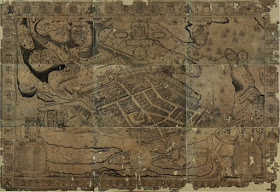One of the most interesting items in our archival collection is a 17th century pictorial map of Galway. The item attracted the attention of James Joyce who in 1912 described the map:
The strangest and most interesting historical document in the city archives is the map of the city made for the Duke of Lorraine in the seventeenth century, when His Highness wished to be assured of the city’s greatness on the occasion of a loan requested of him by his English confrere, the happy monarch. The map full of symbolic expressions and engravings....The margins of the parchment are heavy with the heraldic arms of the tribes, and the map itself is little more than a topographical symphony on the theme of the number of tribes. Thus the map maker enumerates and depicts fourteen bastions, fourteen towers on the wall. Fourteen principal streets, fourteen narrow streets and then sliding, seven gardens, seven alters..., seven markets and seven other wonders.
 |
| The list of 14 'Bastions' |
Rome boasts seven hills,
The Nile its seven'fold streams,
Around the pole seven radiant planets gleam;
Galway, Rome of Connacht, twice equals these;
She boasts twice seven illustrious families;
She boasts twice seven illustrious families;
 |
| The Rome of Connacht? Gate with a flag reading SPQG |
Read more of the story behind this fascinating map in this month’s edition of History Ireland .
You can access the map on line at: http://archives.library.nuigalway.ie/citymap
 |
| #2 of the 14 Bastions which appear on the map |
 |
| The coats of Arms of four of the fourteen tribes of Galway which appear on the margins of the map |

No comments:
Post a Comment